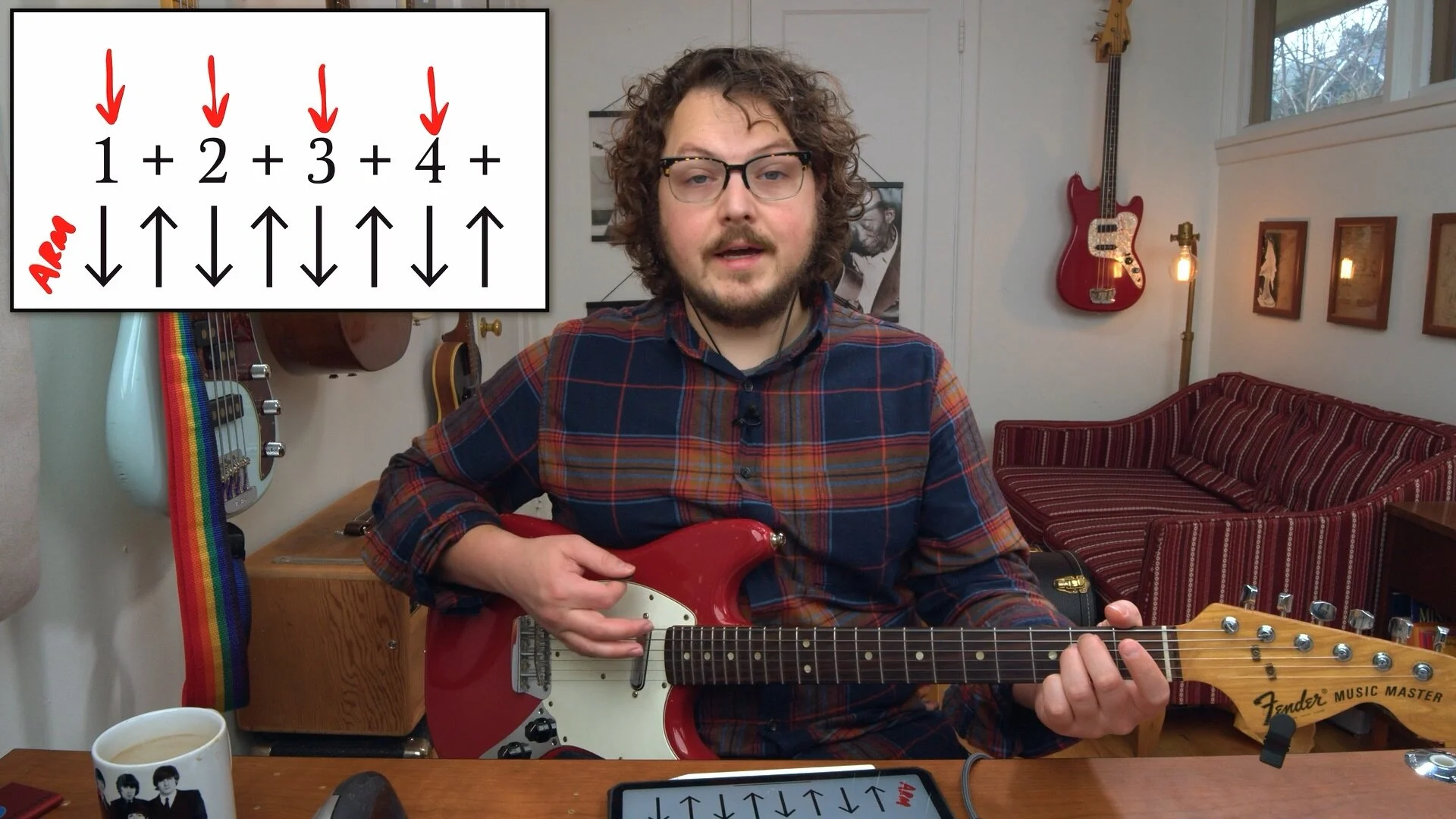Live Stream | 29
Office Hours
This was a fun stream - there were MANY questions about soloing over chord tones, so I want to set up a set of links here for resources:
MTM 16, 17, and 18 will help you understand how to make melodic phrases, which is foundational to making solos.
CAGED Soloing series helps you take these melody-making concepts and apply them to specific chord progressions in specific.
Why Pentatonic part 1 helps you understand that the pentatonic scales are dope BECAUSE they a) fit the guitar well and b) they allow for you to EASILY adapt to nearly any mode - this is to help solidify that the pentatonic scale is really just a scaffolding of the major and minor scale.
There were plenty of other great questions, too!
Read More
Live Stream | 28
Office Hours
This was a fun one. We talked about left and right hand synchronization exercises and how to think about soloing over specific chord progressions. I used this E Major Jam Track
We also discussed how to move out of your comfort zone to learn new things. How much to take on at once and how to integrate new stuff into your comfort/thinking zone.
We talked a little about how to figure out strumming patterns and I recommended starting with my strumming series. That will be a great foundation for learning to hear progressions in the music you listen to.
We also talked a bit about how sus chords work and how to start figuring out what you're doing when you noodle around. We also went into drone notes a little bit.
We also talked more about dominant chords, and harmonic and melodic minor. I used this A Minor Jam Track to mess with wether to use a Mixolydian scale or just a modified A Minor Scale (aka, a harmonic minor scale.)
I also fielded some live questions from the chat and we discussed some nice ideas about gear, DAWs, audio interfaces, and a few other great questions. Also, Ernie the dog made an appearance.
Read More
MTM | 20
Noodling Is Important!
In this lesson I talk about noodling - what it is first, then how to use it to "hear what you sound like." From there I give some strategies for how to gradually get from the mindful, deliberate mindset where effective practice happens, to the place where you can implement that stuff in the flow state of noodling. Essentially, if you train your noodly autopilot, you can get to a place where you're taking a solo without having to think too hard about it! This takes practice, and this lesson is about how to practice that.
Here are my jam tracks SPJ Jam tracks
The previous MTM lessons were all about deliberately and purposefully making melodies - this lesson is about leaving that alone sometimes and just flowing.
Read More
Strumming Patterns | 05
6/8 and 3/4 Beats
In this lesson, we discuss the difference between 6/8 and 3/4 strumming patterns using more drum beat recording software. I also introduce the idea of adding a "P" for pick into your strumming patterns. Its pretty fun!
Read More
Strumming Patterns | 04
Swing vs. Straight
In this lesson we explore the difference between swing & straight rhythms using some funny weird recording software. I help you understand the difference AND help you practice strumming in swing and straight rhythm. It’s pretty fun!
Read More
Music Theory For Guitar | 07
Diminished & Augmented Triads
Music Theory for Guitar is back. In this 7th installment of lessons, I'm going to help you get acquainted with Diminished and Augmented triads. In this overview lesson, I'll talk a little bit about HOW to make these chords and how they fit on the guitar. In the next set of homework lessons, I'll hone in on the main concepts to help the ideas get stuck in your head, and then we'll end with a nice play-along practice track.
Other lessons in this series:
- Homework 1
- Homework 2
- Practice (coming soon)
Read More
Strumming Patterns | 03
Playing to a Beat
In this lesson we take our previous strumming patterns and play them to a beat. From there we discover the difference between 8th note and 16th note strumming patterns and how to explore playing them over a variety of tempos.
Explore the 16th and 8th note play-along tracks while you practice strumming patterns. If you come up with a pattern you like or feel inspired to write a cool chord progression or something else, share it on the community forum post for this lesson!
Read More
Live Stream | 27
OFFICE HOURS, Q&A SATURDAY
This was a fun one! We talked about Major and Minor keys and how chord progressions can be Natural, Harmonic, and Melodic minor and how that relates to the secondary dominants in the Major Key. The Pixies "Where is My Mind" came up as an example.
We also talked about jamming with friends, setting up a pedal board, and a few other things. It was a lot of fun! If you have follow-up questions or progress related to any of these concepts, post about it on the community forum.
Read More
Strumming Patterns | 02
Compound Patterns
In this lesson I build on what we talked about in the previous strumming lesson by introducing compound strumming patterns. The idea here is that you can take two measures to play a whole pattern. I walk you through the concept and give ideas for how to build your own compound strumming patterns.
Read More
Live Stream | 26
OFFICE HOURS Q&A FRIDAY
This was a fun one! We discussed a wide range of things from alternate tunings to chord substitutions to recording software to general guitar concepts and CAGED thoughts. It was a lot of fun. At the end I decided to make up and record a little spontaneous jam just for fun with guitar, bass, and drums. This was a fun one.
Read More
Strumming Patterns | 01
Reduction
In this lesson I break down some nice concepts about strumming in 4/4. The reduction technique is one I use with students who are having particular difficulty learning strumming patterns on guitar. I hope you find it useful and I hope it helps even a few seasoned players think about they way they strum. Also, let me know if you're still having difficulty!
Read More
Live Stream | 25
OFFICE HOURS, Q&A SATURDAY
This was a fun one - we talked about a lot of things! Whole tone scales, CAGED system stuff, wether you should or shouldn't overlay pentatonic scales on top of each other, how to set up a practice routine, a few thoughts about playing bass guitar, and more!
Read More
Song Analysis | 05
Yesterday | Chord and Melody Analysis pt. 2
In this lesson, I'm analyzing the bridge, middle part, or B part (whatever you'd like to call it is acceptable) of the Beatles' "Yesterday."
We did most of the groundwork in the first lesson and since the bridge shares a lot of the same chords as the verse, I brush over those shared parts a little quicker in this lesson to focus on the parts that are unique to the bridge.
Read More
Live Stream | 24
OFFICE HOURS, Q&A FRIDAY
In this livestream I talked a bit about CAGED Soloing, how to solo over an atypical chord progression, and a bit about the difference between rhythm's like 6/8, 3/4 as well as funk and sing rhythm. There were a few other nice questions from Patrons. It was a fun time.
Read More
Song Analysis | 04
Yesterday | Chord and Melody Analysis pt. 1
In this lesson, I examine the chord progression and melody of the Beatles song "Yesterday" and talk about what key its in, how the chord progression uses secondary dominant chords borrowed from the relative minor, and how the melody interacts with the chords using the major scale and the melodic minor scale. We discuss how each note of the melody interacts with each chord to create interesting tension and release as well as how the melody notes affect the chords.
If you want to play along to the track yourself, check out the tablature below and the jam track to play along to the verse and chorus. If you're feeling adventurous, trying making your own voicings of the chord progression by studying the fingerboard dots on the jam track or try mapping out a solo or even a few different places to play the melody.
In part 1, I get into the verse or A section of the song. The next lesson (coming soon) goes over the next part of the song.
Read More
MTM | 19
Melody Arrangement
In this third melody-writing lesson (check out lesson 1 and 2) I get into how to arrange melodic phrases into sets. Things start sounding a lot more like a melody from a song, especially when we tackle C Phrases. I get into details about how to arrange melodic phrases over a handful of different chord progressions, including how to sneakily play the same melody over two separate chords!
Read More
MTM | 18
Melody Morphs
In this lesson, we get more specific about those primordial melodies we made in the previous MTM. Using the Melody Morphs sheet (attached), I walk you through how to create an A phrase and a B phrase with some sneaky techniques. I hinted at C phrases, but we'll get into that in another lesson.
Have fun making melodies using Add, Subtract, Flip, Change and Relocate and post your discoveries on thecommunity forum post for this lesson.
Read More
MTM | 17
Melody Making Basics
In this lesson, I get into the basics of melody making: building melodic phrases. Rules are meant to be broken pretty much all the time in music, but I lay down some nice simple guidelines for how to create melodic phrases using the Melody Quick Scratch Paper.
Read More
Winter "Live" Lesson | 02
Movable Chords-in-a-Key Finder Using Bar Chords
This holiday season is the weirdest I've ever dealt with. I'm not able to live stream right now due to being out of town and in quarantine, but I'll still me putting out lessons in place of the live streams over the next few weeks on top of the usual Monday content.
In this lesson, I talk about handy I-IV-V shapes on the E and A strings and how they link together to create this easy-to-remember shape for quick chord progression writing.
Then I dig into an approach on songwriting: rapid fire, timed songwriting blips. I don't call them that in the video, but thats essentially what they are. Quick primordial song stuff. Basically it's about practicing the essential elements of songwriting and being quick about it.
Read More
MTM | 16
Why Pentatonic? Part 2
In this little part 2 lesson, I talk about how old the Pentatonic Scale is (hint: REALLY OLD) and how the Major Scale and the Pentatonic scale kind of play a similar role in melody making - you get to pick and choose. I then assign a little homework based on this lesson.
If you'd like to post said homework, related notes and noodling, or further questions on the topic, visit the community post for this lesson.
Read More




















